Testing The World’s Best APUs: Desktop AMD Ryzen 4750G, 4650G and 4350G
by Dr. Ian Cutress on December 16, 2020 10:30 AM ESTCPU Benchmarks: Synthetic
All of our benchmark results can also be found in our benchmark engine, Bench.
Dwarf Fortress 0.44.12: Link
Emulating the ASCII interfaces of old, this title is a rather complex beast, which can generate environments subject to millennia of rule, famous faces, peasants, and key historical figures and events. The further you get into the game, depending on the size of the world, the slower it becomes as it has to simulate more famous people, more world events, and the natural way that humanoid creatures take over an environment. Like some kind of virus.
For our test we’re using DFMark. DFMark is a benchmark built by vorsgren on the Bay12Forums that gives two different modes built on DFHack: world generation and embark. These tests can be configured, but range anywhere from 3 minutes to several hours. After analyzing the test, we ended up going for three different world generation sizes:
- Small, a 65x65 world with 250 years, 10 civilizations and 4 megabeasts
- Medium, a 127x127 world with 550 years, 10 civilizations and 4 megabeasts
- Large, a 257x257 world with 550 years, 40 civilizations and 10 megabeasts
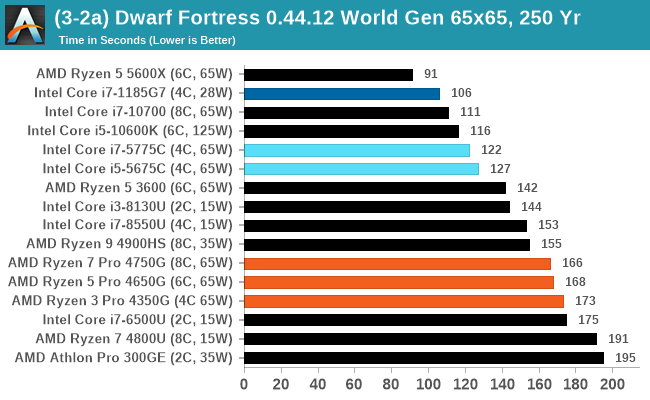
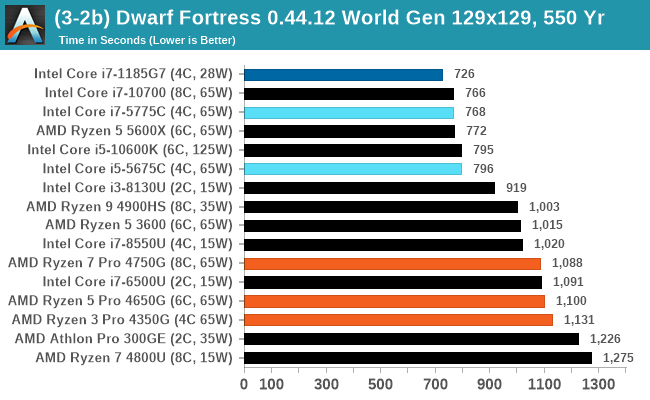
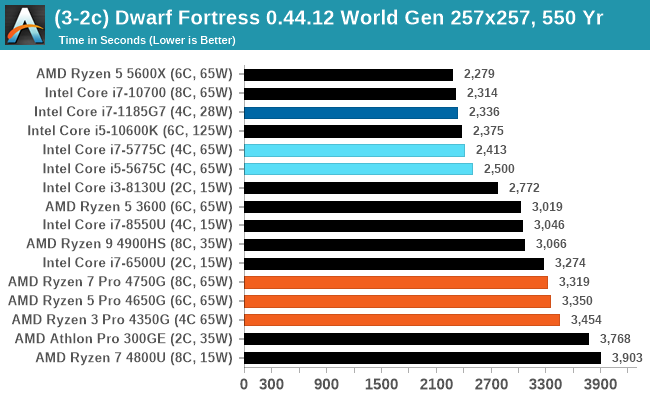
Dolphin v5.0 Emulation: Link
Many emulators are often bound by single thread CPU performance, and general reports tended to suggest that Haswell provided a significant boost to emulator performance. This benchmark runs a Wii program that ray traces a complex 3D scene inside the Dolphin Wii emulator. Performance on this benchmark is a good proxy of the speed of Dolphin CPU emulation, which is an intensive single core task using most aspects of a CPU. Results are given in seconds, where the Wii itself scores 1051 seconds.
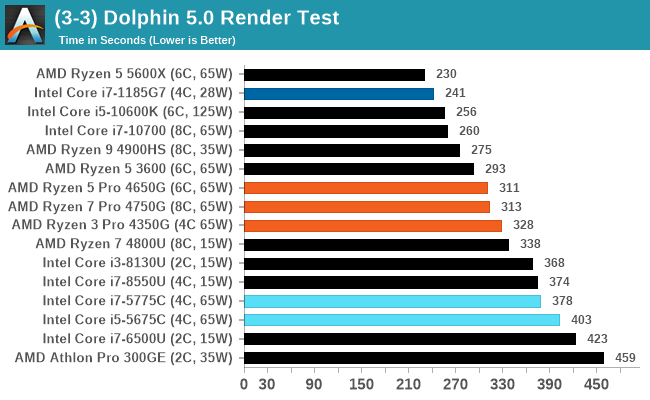
3D Particle Movement v2.1: AVX2/AVX512
This is the latest version of this benchmark designed to simulate semi-optimized scientific algorithms taken directly from my doctorate thesis. This involves randomly moving particles in a 3D space using a set of algorithms that define random movement. For v2.1, we also have a fully optimized AVX2/AVX512 version, which uses intrinsics to get the best performance out of the software.
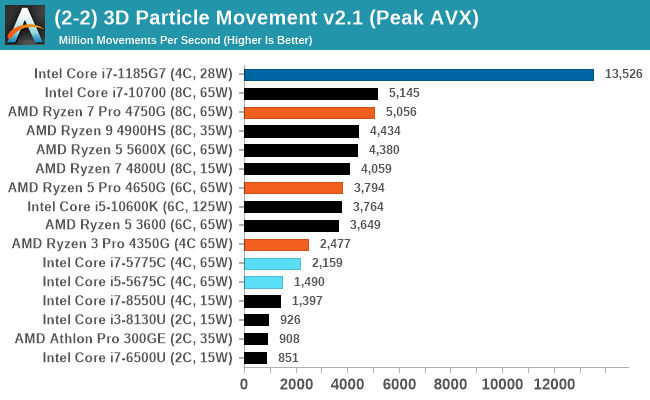
Tiger Lake wins here as it has an AVX512 unit.
y-Cruncher 0.78.9506: www.numberworld.org/y-cruncher
If you ask anyone what sort of computer holds the world record for calculating the most digits of pi, I can guarantee that a good portion of those answers might point to some colossus super computer built into a mountain by a super-villain. Fortunately nothing could be further from the truth – the computer with the record is a quad socket Ivy Bridge server with 300 TB of storage. The software that was run to get that was y-cruncher.
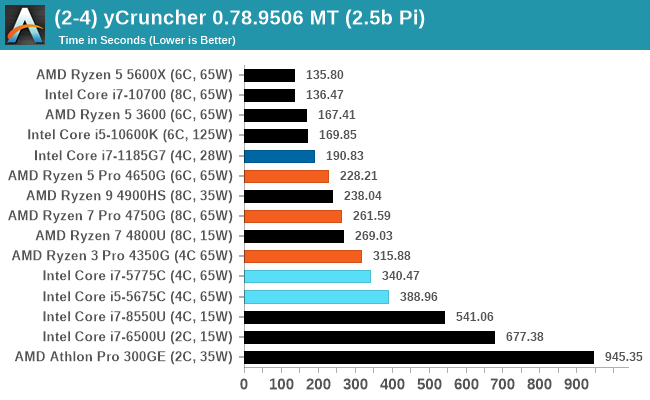
This is another AVX-512 test.
Linux OpenSSL Speed: SHA256
One of our readers reached out in early 2020 and stated that he was interested in looking at OpenSSL hashing rates in Linux. Luckily OpenSSL in Linux has a function called ‘speed’ that allows the user to determine how fast the system is for any given hashing algorithm, as well as signing and verifying messages.
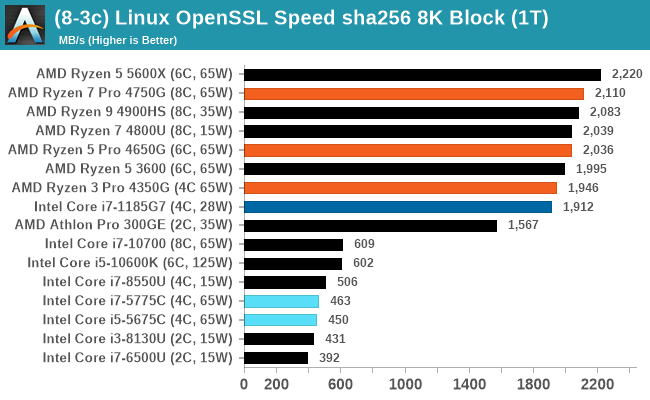
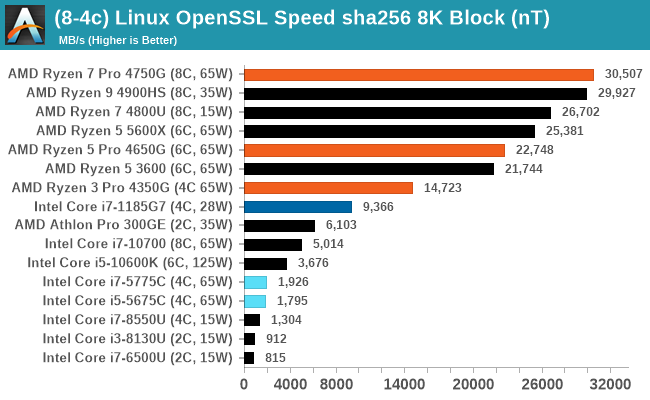










104 Comments
View All Comments
NedHej - Wednesday, December 16, 2020 - link
Why, for the integrated tests, are you showing 360pMin and 1080pMax?One of those I'm never going to use, and the other I'm not going to expect an IGPU to deliver.
Sure the 1080pMax is good to know but why not pick something sensible, like 1080pMin or 720pMedium, to suggest a setup people might actually want to know about?
lucasdclopes - Wednesday, December 16, 2020 - link
I entered the comment section to say the same thing. For IGP 1080pmax is too much but 360p/600plow is too little. Needs a 768p medium.StevoLincolnite - Wednesday, December 16, 2020 - link
Yeah. Also agree. 720P is what I would be targeting if I intend to game on integrated graphics.360P/480P and 1080P are not my use cases/expectations.
n13L5 - Saturday, January 16, 2021 - link
Yeah, this test was done for or by a theoretical person, not a gamer, who would want to use values that give them an idea if it was going to be useful for gaming or not.I also missed the GTX 1650, just to see how APUs compare to the cheapest *modern* card you can buy at $160 or so (unless there's a bitcoin mining boom).
Granted, if you buy an $160 GPU, and keep in the price range of the 4750G, you'd need to find a used i5-7xxx or so on eBay for under $100.
But that would surely run better than anything they tested here, other than the GTX-1080...
jakky567 - Sunday, December 20, 2020 - link
I'd argue 768p is a weird resolution in context of these chips, as I'd expect them to be used with an external display. In games, if you're using a lower resolution, I think 720p makes more sense anyhow.n13L5 - Wednesday, December 30, 2020 - link
True.Even though, people do play and benchmark these on YT @1080p with somewhat reduced settings.
Its not horrible looking, but obviously no ray tracing there...
ricebunny - Wednesday, December 16, 2020 - link
Tests “World’s best APUs”, but does not include Apple M1??Tomatotech - Wednesday, December 16, 2020 - link
I admire the M1 but it isn’t an APU. That APU name is just AMD’s branding and only applies to their chips.(intel’s IGPUs aren’t tested here either.)
nandnandnand - Wednesday, December 16, 2020 - link
Hogwash. If Intel makes a CPU with a faster iGPU than AMD, then it's a better APU. Period.Technically, the Xbox Series X and PS5 have the world's best APUs. But good luck running your own OS on them.
ricebunny - Wednesday, December 16, 2020 - link
Actually, the review does include a soldered Intel iGPU of Tiger Lake family. Plus a Broadwell family desktop CPU.@Ian: Can you specify in more detail per game what the max settings are?
Assuming that for Civ6 that means Ultra settings (by default without AA), I get 33 FPS on the M1 mini. That's 65% faster than the 4750G and entirely playable.